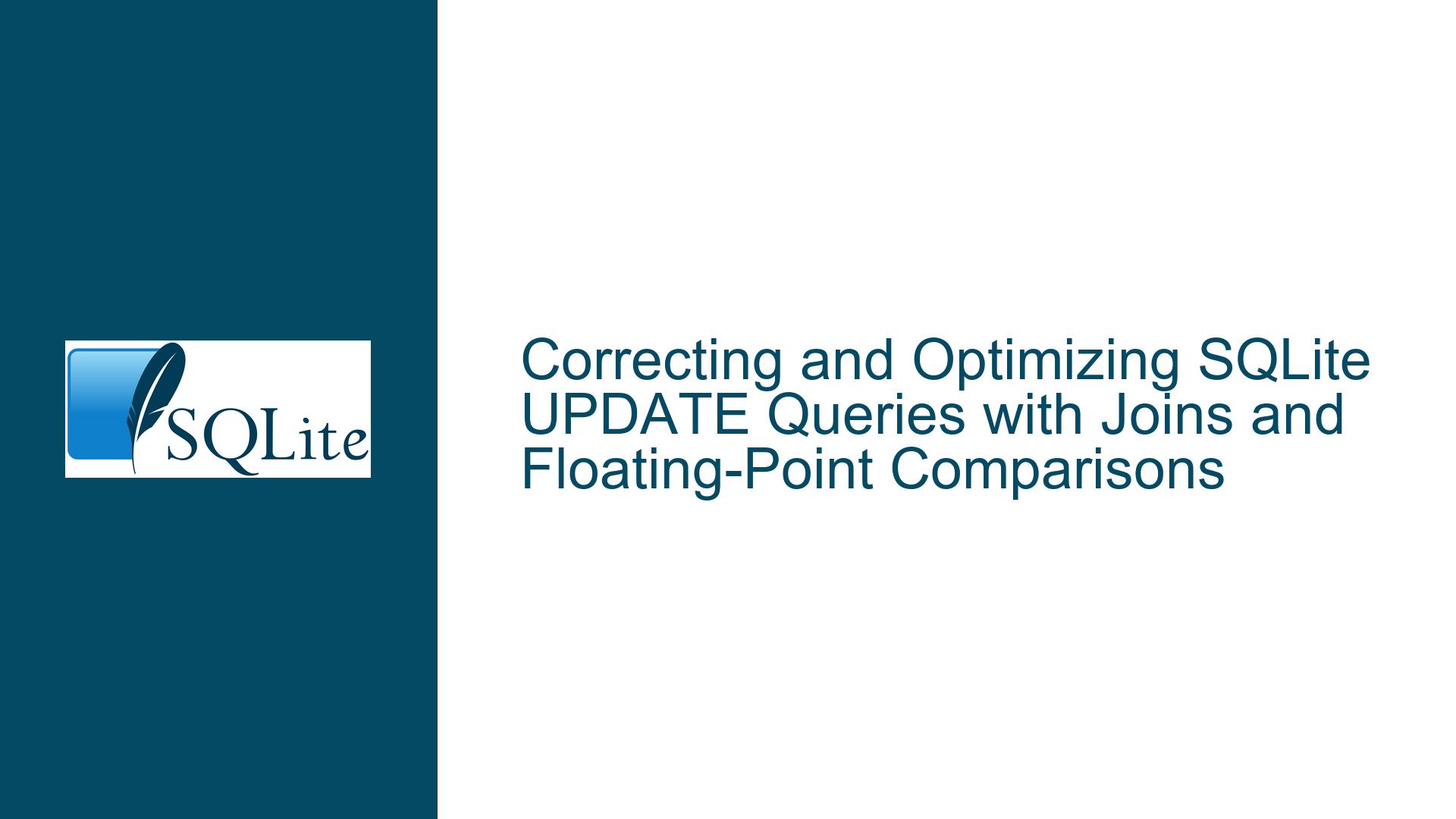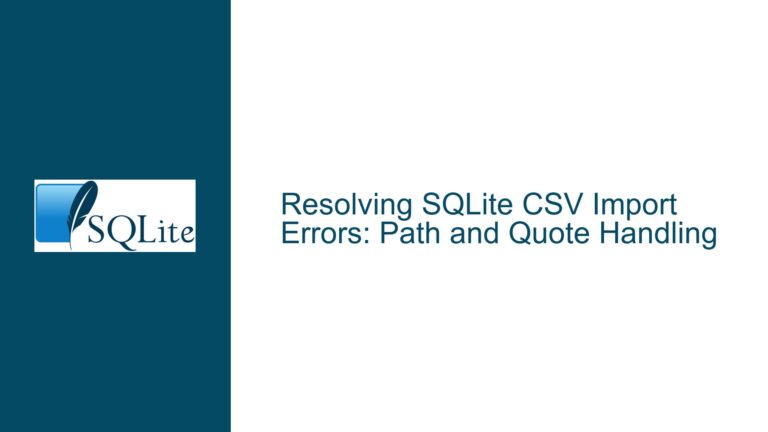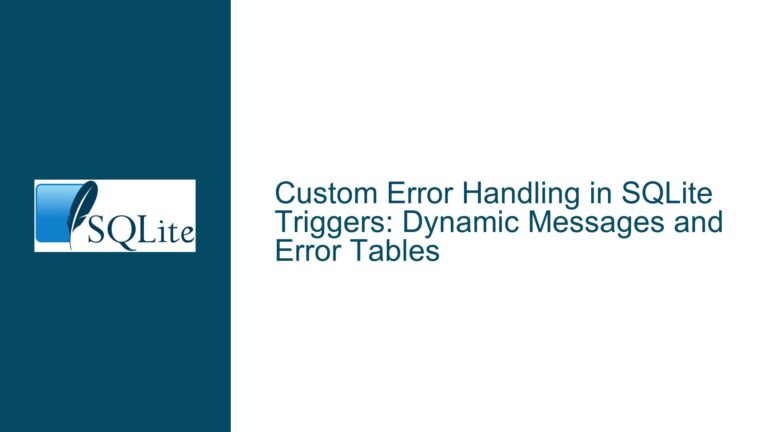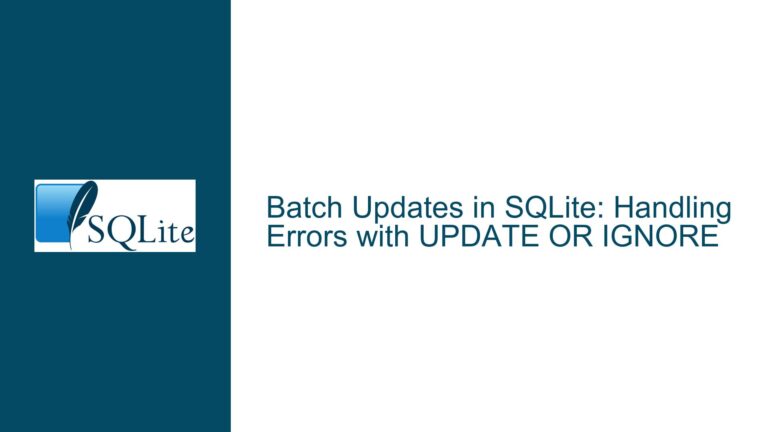Correcting and Optimizing SQLite UPDATE Queries with Joins and Floating-Point Comparisons
Understanding the Problem: Updating t1.start_station_name Based on Latitude and Longitude Matching
The core issue revolves around updating the start_station_name column in table t1 using data from another table, which we can infer is named s. The goal is to match rows between t1 and s based on two columns: start_lat (latitude) and start_lng (longitude). Once a match is found, the start_station_name in t1 should be updated to the corresponding value from s.
The initial query provided by the user attempts to perform this update but contains a critical flaw: the table s is not properly defined or joined in the query. This omission makes the query syntactically incorrect and functionally incomplete. Additionally, the user does not specify whether start_lat and start_lng are stored as floating-point numbers, which introduces potential complications due to the imprecision of floating-point comparisons.
The problem can be broken down into three key areas:
- Syntax and Logical Errors: The query does not correctly reference the
stable, leading to a failure in execution. - Data Integrity Concerns: If
start_latandstart_lngare floating-point numbers, direct equality checks may fail due to minor precision differences. - Update Behavior: The query must handle cases where no matching rows are found in
sto avoid unintendedNULLvalues int1.
Potential Causes of the Issue: Missing Table References and Floating-Point Precision
The primary cause of the issue is the absence of a proper reference to the s table in the original query. In SQLite, when performing an UPDATE operation that relies on data from another table, the secondary table must be explicitly referenced, either through a subquery or a join. The original query attempts to use s.start_station_name without defining s, resulting in a syntax error.
Another potential cause is the use of floating-point numbers for start_lat and start_lng. Floating-point numbers are inherently imprecise due to their binary representation, which can lead to unexpected behavior when performing equality checks. For example, two latitude values that appear identical to the naked eye might differ slightly in their binary representation, causing the equality check to fail. This issue is particularly relevant in geospatial data, where small discrepancies can have significant implications.
Finally, the query does not account for cases where no matching rows are found in s. If a row in t1 does not have a corresponding match in s, the UPDATE operation could set start_station_name to NULL, which may not be the desired behavior. This oversight can lead to data integrity issues, especially if start_station_name is a critical field.
Resolving the Issue: Syntax Corrections, Floating-Point Handling, and Update Logic
To address the issues outlined above, we need to refine the query in three key areas: syntax, floating-point handling, and update logic.
1. Correcting the Syntax: Properly Referencing the s Table
The first step is to ensure that the s table is correctly referenced in the query. This can be achieved using a subquery or a join. The subquery approach involves embedding a SELECT statement within the UPDATE query to fetch the appropriate start_station_name from s. Here is an example:
UPDATE t1
SET start_station_name = (
SELECT s.start_station_name
FROM s
WHERE s.start_lat = t1.start_lat
AND s.start_lng = t1.start_lng
);
This query updates t1.start_station_name with the corresponding value from s where the latitude and longitude match. However, this approach has a limitation: if no matching row is found in s, the subquery will return NULL, which will overwrite the existing start_station_name in t1.
2. Handling Floating-Point Precision: Using Approximate Comparisons
To address the issue of floating-point precision, we can replace the equality checks with a range-based comparison. This involves defining a small tolerance value (e.g., 0.000001) and checking whether the difference between the two values falls within this range. Here is an example:
UPDATE t1
SET start_station_name = (
SELECT s.start_station_name
FROM s
WHERE ABS(s.start_lat - t1.start_lat) < 0.000001
AND ABS(s.start_lng - t1.start_lng) < 0.000001
);
In this query, ABS(s.start_lat - t1.start_lat) < 0.000001 ensures that the latitude values are considered equal if their difference is less than the specified tolerance. The same logic applies to start_lng.
3. Preserving Existing Values: Using COALESCE to Avoid NULL Overwrites
To prevent NULL values from overwriting existing start_station_name values in t1, we can use the COALESCE function. This function returns the first non-NULL value in its argument list. By including t1.start_station_name as the second argument, we ensure that the original value is preserved if no match is found in s. Here is the updated query:
UPDATE t1
SET start_station_name = COALESCE(
(SELECT s.start_station_name
FROM s
WHERE ABS(s.start_lat - t1.start_lat) < 0.000001
AND ABS(s.start_lng - t1.start_lng) < 0.000001),
t1.start_station_name
);
This query combines all three improvements: proper table referencing, floating-point handling, and NULL prevention.
Alternative Approach: Using an Explicit Join
SQLite also supports UPDATE queries with explicit joins, which can improve readability and performance in some cases. Here is an example:
UPDATE t1
SET start_station_name = s.start_station_name
FROM s
WHERE ABS(s.start_lat - t1.start_lat) < 0.000001
AND ABS(s.start_lng - t1.start_lng) < 0.000001;
This query achieves the same result as the previous one but uses a join instead of a subquery. Note that this syntax is specific to SQLite and may not be supported in other database systems.
Best Practices for Similar Scenarios
When working with UPDATE queries that involve data from multiple tables, consider the following best practices:
- Explicitly Define Table Relationships: Always ensure that all tables referenced in the query are properly defined and joined. This avoids syntax errors and ensures logical correctness.
- Handle Floating-Point Comparisons Carefully: Use range-based comparisons or specialized functions (e.g.,
ROUND) to account for floating-point imprecision. - Prevent Unintended
NULLValues: UseCOALESCEor similar functions to preserve existing data when no match is found. - Test with Sample Data: Before running the query on the full dataset, test it with a small subset to verify its correctness and performance.
- Back Up Data: Always back up your data before performing bulk updates, especially when working with critical fields.
By following these guidelines, you can ensure that your UPDATE queries are both accurate and efficient, minimizing the risk of data corruption or unintended behavior.
Conclusion
The issue of updating t1.start_station_name based on latitude and longitude matching involves several nuanced considerations, including proper table referencing, floating-point precision, and update logic. By addressing these aspects systematically, we can construct a robust and reliable query that achieves the desired outcome without compromising data integrity. Whether you choose to use subqueries, explicit joins, or a combination of both, the key is to approach the problem methodically and test your solution thoroughly before deploying it in a production environment.






